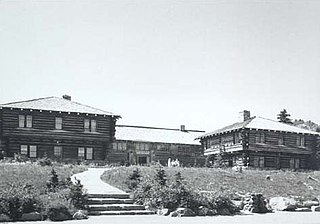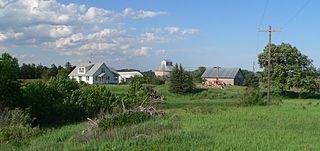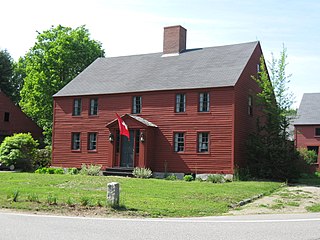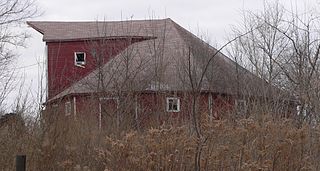
Filley is a village in Gage County, Nebraska, United States. The population was 124 at the 2020 census.

The Thomas Stone National Historic Site, also known as Haberdeventure or the Thomas Stone House, is a United States National Historic Site located about 25 miles (40 km) south of Washington D.C. in Charles County, Maryland. The site was established to protect the home and property of Founding Father Thomas Stone, one of the 56 signers of the United States Declaration of Independence. His home and estate were owned by the Stone family until 1936.

The Hermitage, located in Ho-Ho-Kus, Bergen County, in the U.S. state of New Jersey, is a fourteen-room Gothic Revival house museum built in 1847–48 from designs by William H. Ranlett for Elijah Rosencrantz, Jr. Members of the Rosencrantz family owned The Hermitage estate from 1807 to 1970. The site was designated a National Historic Landmark for the excellence of its architecture and added to National Register of Historic Places in 1970 and was added to the New Jersey Register of Historic Places in 1971.

Military Avenue is a central thoroughfare located in Omaha, Nebraska. A segment of the road located at the junction of West 82nd and Fort Streets was listed on the National Register of Historic Places in 1993. Today Military Road, which begins at Nebraska Highway 64 as Nebraska Highway L-28K, ends at Bennington Road near North 204th Street.

This is a list of the National Register of Historic Places listings in Douglas County, Nebraska.

This is intended to be a complete list of the properties and districts on the National Register of Historic Places in Pierce County, Washington, United States. Latitude and longitude coordinates are provided for many National Register properties and districts; these locations may be seen together in an online map.

The Yakima Park Stockade Group, also known as North and South Blockhouses and Stockade at Sunrise, is a building complex consisting of four log buildings at the Sunrise Visitors Center area in the northeast part of Mount Rainier National Park. The complex is architecturally significant as a particularly fine example of rustic frontier log architecture. The first of the blockhouses and the stockade were built in 1930, while the second blockhouse followed in 1943. It was declared a National Historic Landmark in 1987. It is in turn part of the Mount Rainier National Historic Landmark District, which encompasses the entire park and which recognizes the park's inventory of Park Service-designed rustic architecture.

This is a list of the National Register of Historic Places listings in Gage County, Nebraska.

This is a list of the National Register of Historic Places listings in Lancaster County, Nebraska.

The Oliver Filley House is a historic Greek Revival house at 130 Mountain Avenue in Bloomfield, Connecticut, United States. It was occupied by Captain Oliver Filley and his family, a tinsmith who served as a captain in the Connecticut militia during the War of 1812.

White Horse Farm, also known as the Elijah F. Pennypacker House, is a historic home and farm located in Schuylkill Township, Chester County, Pennsylvania. The original section was built around 1770. In the 19th century, it was the home of abolitionist Elijah F. Pennypacker and served as a station on the Underground Railroad. The farm was added to the National Register of Historic Places in 1987.

The Nebergall "Knoll Crest" Round Barn is located between Davenport and Blue Grass in rural Scott County, Iowa, United States. It was built in 1914, and has been listed on the National Register of Historic Places since 1986.

The Dyas Hexagonal Barn is a historical building located near Bellevue in rural Jackson County, Iowa, United States. Built in 1921, it is a round barn measuring 50 feet (15 m) around, with red horizontal siding on a stone foundation, a tin roof, and a central wood stave silo extending through the roof. Despite the common name, the building is actually eight-sided, and is also known as the Dyas Octagonal Barn. Originally the roof was flat or almost flat; it is one of four round barns known to have been built on the same farm. It has been listed on the National Register of Historic Places since 1986.
This is a list of the National Register of Historic Places listings in Mount Rainier National Park.

The Frank Pisar Farmstead, also known as Joseph Kastanek Farm, is a house and a group of farm buildings in Dorchester, Nebraska, United States. The property was filed in 1872 by Frantisek "Frank" Pisar, an immigrant from Bohemia. The farmstead was originally an 80-acre (32 ha) tract but was expanded in size to over 300 acres (120 ha) by 1885. A stone house was built in 1977, and a stone barn in 1888. The property also includes poultry sheds, a hog house, a corncrib, and a privy. It was listed on the National Register of Historic Places on August 6, 1986.

Ehlers Round Barn, in Roca, Nebraska, was completed in 1924 by Harvey W. Ehlers. It was listed on the National Register of Historic Places for its innovative and efficient architecture in 1995.

The Elijah Locke House is a historic house at 5 Grove Road in Rye, New Hampshire. Traditionally ascribed a construction date of 1739, it is one of the oldest surviving buildings in New Hampshire's Seacoast region. It was listed on the National Register of Historic Places in 1979.

The Asa May House is a historic farmstead on Blood Brook Road in West Fairlee, Vermont. Developed in the late 18th century, the c.1800 house is a rare statewide example of Federal period architecture, built for West Fairlee's first town clerk. The farmstead property, including a barn, sheds, and period landscape elements, was listed on the National Register of Historic Places in 1993.

The Couser Barn is a dodecagon-shaped round barn in Cedar County, Nebraska. It was built during 1912-13 for William Couser, a farmer who came to Nebraska from Shelby County, Iowa in 1899. It was built in the second phase of centric barn construction in Nebraska, when light balloon framing allowed for large open spaces to be created. An oral tradition holds that the design for the barn came from the University of Nebraska.

The Elijah Mills House is a United States historic house at 45 Deerfield Road in Windsor, Connecticut. Built in 1822, it is a well-preserved local example of a Federal period brick house. It was listed on the National Register of Historic Places in 1985.





















